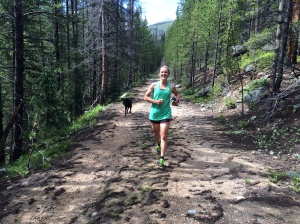By Abraham Lincoln SBSM Trainer Michelle Beachem
Can you believe there are only two months until the Colfax Marathon? Since many of you are likely training full tilt right now, I thought today would be a good day to discuss a few common running injuries and ways to prevent them, so that you can be at top form come race day! Remember, this article is intended to add to your knowledge and provide general guidance, and should not be used to diagnose injury. If you experience pain that doesn’t improve with rest, please consult your doctor for an individualized diagnosis and treatment program.
- “Runner’s knee” is a common overuse injury. Runner’s knee has multiple causes, but It often occurs when your patella is out of alignment. Overuse, especially over a long period of time can cause the cartilage on your kneecap can wear down. When that happens, you may feel pain or stiffness around the patella. You many notice this more frequently when doing activities such as: going up or down stairs, squatting, or sitting with the affected knee/knees bent for a long time.
- Stress fractures are small cracks in a bone that often cause pain and discomfort. It typically affects runners in their shins and feet and is often due to pushing too hard before your body is used to certain level of exertion. It is typically determined that one has a stress fracture when one has pain that gets worse with activity and subsides with rest. Rest with a stress fracture is very important, as continued stress on the injured area can lead to more serious injuries.
- Shin splints. This is pain that happens in the front or inside of the lower leg along the tibia, commonly referred to as the shin bone. Shin splints are a common occurrence after changing running routine. You many experience shin splints after running longer distances or increasing the number of days you run, too quickly. People who have flat feet are more prone to shin splints. Treatment of shin splints includes: rest, stretching exercises, and slow return to activity after several weeks of healing
- Achilles tendinitis is the inflammation of the Achilles tendon, the large tendon that attaches the calf muscle to the back of the heel. Achilles tendinitis causes pain and stiffness in the area of the tendon, especially in the morning and with activity and is typically occurs due to repetitive stress to the tendon. Adding too much additional distance to your running routine can cause it. Tightness in your calf muscles can also contribute to the inflammation. Treatment of Achilles tendinitis includes: rest, icing the area, and calf stretches
- Muscle pulls are small tears in your muscles, also called a muscle strain. It’s often caused by overstretching a muscle. If you pull a muscle, you may feel a popping sensation when the muscle tears. Treatment includes RICE: rest, ice, compression, and elevation. Muscle pulls commonly affects these muscles: hamstrings, quadriceps, calf, groin
- IT (iliotibial) band syndrome causes pain on the outside edge of the knee. The IT band is a ligament that runs along the outside of the thigh, from the top of the hip to the outside of the knee. IT band syndrome often happens when this ligament thickens and rubs the patella causing inflammation. Treatment of the IT band includes: cutting back on exercise, heat and stretching before exercise, and icing the area after activity
- Blisters are fluid-filled sacks on the surface of the skin. They are caused by friction between your shoes/socks and skin. To help prevent blisters: start using new shoes gradually, wear socks with a double layer, apply petroleum jelly or anti-friction cream on areas prone to blisters
Obviously what’s even better than treating these injuries is preventing them altogether, so be sure to gradually increase your training volume, avoiding rapid jumps in volume or intensity, as is typical of people excited to train for their first race. Listen to your body, rest when you need it, and reach out to a reputable coach if you’re looking for a more structured training schedule leading up to your race. Here’s to all the happy and healthy runners out there!

